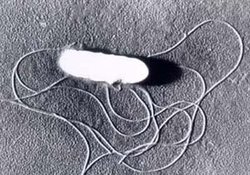Listeria monocytogenes
|
|
| Listeria monocytogenes | ||||||||||||||
|---|---|---|---|---|---|---|---|---|---|---|---|---|---|---|
 | ||||||||||||||
| Scientific classification | ||||||||||||||
| ||||||||||||||
| Binomial name | ||||||||||||||
| Listeria monocytogenes |
Listeria monocytogenes is a Gram-positive bacterium, in the division Firmicutes, named for Joseph Lister. It is motile by means of flagella. Some studies suggest that 1 to 10% of humans may carry L. monocytogenes in their intestines.
Researchers have found L. monocytogenes in at least 37 mammalian species, both domesticated and feral, as well as in at least 17 species of birds and possibly in some species of fish and shellfish. Laboratories can isolate L. monocytogenes from soil, silage, and other environmental sources. L. monocytogenes is quite hardy and resists the deleterious effects of freezing, drying, and heat remarkably well for a bacterium that does not form spores. Most L. monocytogenes are pathogenic to some degree.
Infection by L. monocytogenes causes the disease listeriosis. The manifestations of listeriosis include septicemia, meningitis (or meningoencephalitis), encephalitis, and intrauterine or cervical infections in pregnant women, which may result in spontaneous abortion (2nd/3rd trimester) or stillbirth. Influenza-like symptoms, including persistent fever, usually precede the onset of the aforementioned disorders. Gastrointestinal symptoms such as nausea, vomiting, and diarrhea may precede more serious forms of listeriosis or may be the only symptoms expressed. Gastrointestinal symptoms were epidemiologically associated with use of antacids or cimetidine. The onset time to serious forms of listeriosis is unknown but may range from a few days to three weeks. The onset time to gastrointestinal symptoms is unknown but probably exceeds 12 hours.
The infective dose of L. monocytogenes is unknown but probably varies with the strain and with the susceptibility of the victim. From cases contracted through raw or supposedly pasteurized milk, one may safely assume that in susceptible persons, fewer than 1,000 total organisms may cause disease. L. monocytogenes may invade the gastrointestinal epithelium. Once the bacterium enters the host's monocytes, macrophages, or polymorphonuclear leukocytes, it becomes blood-borne (septicemic) and can grow. Its presence intracellularly in phagocytic cells also permits access to the brain and probably transplacental migration to the fetus in pregnant women. The pathogenesis of L. monocytogenes centers on its ability to survive and multiply in phagocytic host cells.
L. monocytogenes has been associated with such foods as raw milk, supposedly pasteurized fluid milk, cheeses (particularly soft-ripened varieties), ice cream, raw vegetables, fermented raw-meat sausages, raw and cooked poultry, raw meats (of all types), and raw and smoked fish. Its ability to grow at temperatures as low as 3°C permits multiplication in refrigerated foods.
When listeric meningitis occurs, the overall mortality may reach 70%; from septicemia 50%, from perinatal/neonatal infections greater than 80%. In infections during pregnancy, the mother usually survives. Reports of successful treatment with parenteral penicillin or ampicillin exist. Trimethoprim-sulfamethoxazole has been shown effective in patients allergic to penicillin.
The methods for analysis of food are complex and time-consuming. The present FDA method, revised in September, 1990, requires 24 and 48 hours of enrichment, followed by a variety of other tests. Total time to identification takes from 5 to 7 days, but the announcement of specific nonradiolabled DNA probes should soon allow a simpler and faster confirmation of suspect isolates.
Recombinant DNA technology may even permit 2-to-3 day positive analysis in the future. Currently, the FDA is collaborating in adapting its methodology to quantitate very low numbers of the organisms in foods.de:Listeria fr:Listeria nl:Listeria
